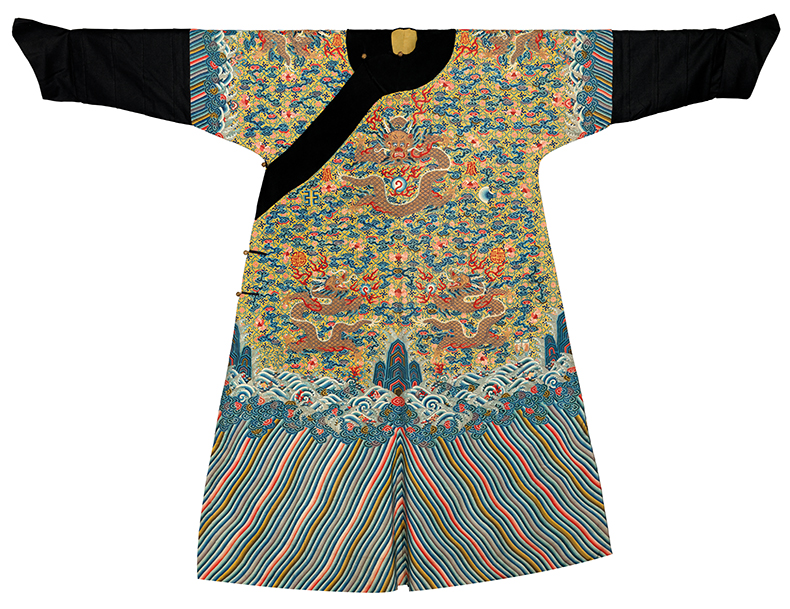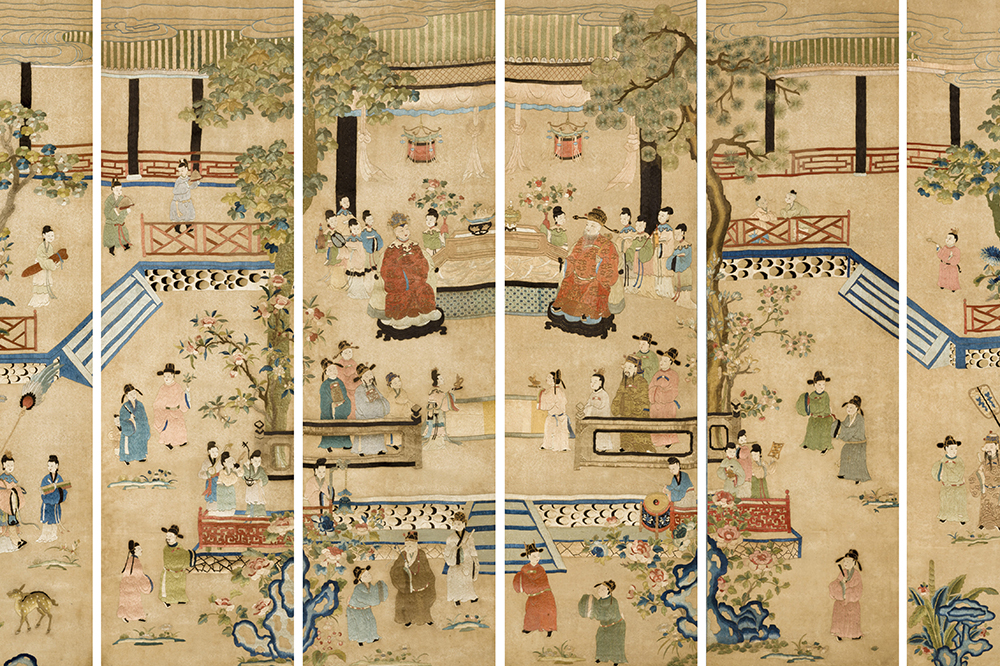From the February 2024 issue of Apollo. Preview and subscribe here.
The production of silk in China, from the cocoons of the mulberry silkworm Bombyx mori, dates back to the Neolithic period. According to myth, the first king, Fu Xi, taught the Chinese to cultivate mulberry bushes and raise silk moths, while Xi-ling Shih, chief wife of the Yellow Emperor Huangdi, discovered how to reel silk after a cocoon fell into her cup of hot tea. The earliest known silk textile fragments have been dated to the fourth millennium BC. By the time the Han emperor Wu (r. 141–87 BC) sent embassies to win allies in Central Asia and the Middle East, initiating the transcontinental silk trade, the technologies of silk-weaving, tapestry and embroidery were highly evolved. Silk textiles and the rules around their production, design and use were integral to the empire’s religious, social and political life, part of an elaborate web of laws inspired by the Confucian principle of li, or the virtue of propriety, which governed imperial, court and clerical life.
From the rise of the Tang Dynasty in the seventh century AD, silk, alongside porcelain, tea and lacquerware, was a strictly controlled trade good, as valuable as gold. Patterned silks also became a vehicle for cultural exchange – textiles document the transmission of motifs across the Persian and Chinese Empires. One significant development was the spread, from the 11th to the 14th century, of kesi or tapestry weaving, a Uyghur specialism, combining silk and gold in ways that increasingly emulated painting. Complex layered gold brocades from the Jin territories, Tibetan Buddhist textiles commissioned by the Mongol Yuan dynasty (1279–1368) and the figured silk velvets of the Ming dynasty (1368–1644) demonstrate the lasting cultural value of silk, in robes, decorative hangings, furnishings and accessories. During the Manchu Qing dynasty (1644–1911), when the European passion for chinoiserie peaked, Chinese silks were sought all over Europe. At the same time, costume in the Imperial Court became important to the Manchu ruling class’s assertion of authority. Imperial silks were distinct from those worn by the Han Chinese majority, with different cuts, colours and motifs assigned for every activity of every member of court, from highest to lowest. Bright yellow and the dragon motif were reserved for the emperor, his empress, his mother and the first-rank imperial consort.
After the Qing dynasty collapsed in 1911, Chinese robes turned up at auction in London and Paris; others were hoarded in Western private collections. But it was in the late 1980s and ’90s that the contemporary market in the West took off. According to the London-based dealer Jacqueline Simcox – at the forefront of the market since the ’80s – famine in Tibet led to the export through Nepal of many textiles that had been saved from destruction by the Chinese in the 1950s, hidden in monasteries: ‘We saw 11th-, 12th-century pieces in the condition they were when first made.’ A small group of dealers used radiocarbon testing to establish a chronology and the evolution of techniques, colours and styles: ‘We taught ourselves as we went along.’ US museums were big buyers, as were individuals from the UK, Europe and Hong Kong. Since 2011, Chinese buyers, from mainland China, Taiwan, Hong Kong, Singapore and elsewhere, have come to the fore. Today the market is much smaller but still competitive. Simcox says: ‘I used to see whole lengths of yellow-ground silk from the 16th century in perfect condition, with drag-ons sewn into them. Now to see a piece a foot long with no mark on it is a luxury.’ Above all, Chinese buyers want ‘an imperial robe with the 12 imperial symbols’ – these were codified in the 18th century by the Qianlong Emperor. Condition is paramount, Simcox says, but ‘You have got to know your costumes. All parts of the robe must match and be of the same date.’ Otherwise, it can be ‘totally without value’. Simcox has available a late Qianlong/early Jiaqing kesi yellow-ground imperial 12-symbol dragon robe (jifu), the symbols arranged in three tiers, the robe never made up.
Yellow-ground imperial 12-symbol dragon robe (jifu) made for the emperor (1790–1800). Courtesy Jacqueline Simcox Ltd, London

Robes for specific roles – such as the blue imperial 12-symbol robe, reserved for ritual sacrifices, that fetched £474,650 at Bonhams London in 2018 – are greatly valued and, Simcox says, ‘rare as hen’s teeth’. While top prices at auction have lagged behind those for ceramics and jade, when a good piece comes up, fierce bidding ensues. Simcox cites an exceptional yellow kesi 12-symbol dragon robe made for the Jiaqing Emperor (r. 1796–1820), from the collection of General Joseph W. Stilwell, which sold for $756,500 (estimate $80,000–$120,000) at Christie’s New York in March 2018. Vicki Paloympis, head of Chinese art at Christie’s New York, says: ‘The yellow colour was as vibrant as you could possibly imagine, which is very rare in textiles from this period.’ According to Gordon Lo, head of sales in the Chinese department at Sotheby’s London, a new generation of young Chinese expats is showing interest in these classic works – the British Museum’s recent exhibition ‘China’s Hidden Century’, which focused on 19th-century art and artefacts, drew groups of young Chinese visitors wearing traditional costume. They seek out 19th-century examples when 18th-century pieces are too costly; yellow and red are the most favoured colours.
Bruce Maclaren, global head of Chinese painting and calligraphy at Bonhams, says that ‘The type of weave is key to value. Kesi or slit tapestry weave textiles are traditionally valued higher than embroideries, satin or damask weave textiles, in part because the time and effort to manufacture kesi was much greater.’
He cites a kesi mandala fragment with imperial portraits from the second quarter of the 14th century (Yuan dynasty) which sold for $51,200 in New York in September. Simcox notes that while Europeans have always collected fragments, interest has spread to the United States and, more recently, Chinese dealers. Despite the fragility of such pieces, Maclaren says that ‘collectors still covet all forms of silk textiles’ – and flags up the sale of a 19th-century six-panel hanging at Bonhams New York in March (estimate $25,000–$40,000).
Linda Wrigglesworth, author of Imperial Wardrobe (1990), a seminal book on the subject, notes that rank badges ‘are sought after and have held their value and increased over the years’. In September 2022, Christie’s New York sold a pair of embroidered gold-ground rank badges from the respected David Hugus collection, made in the Kangxi period (1662–1722) and showing the qilin, a mythical creature. Estimated at $30,000–$50,000, they made $144,900, a much higher than usual price. Paloympis says: ‘The provenance, condition, quality and rarity made the demand very high.’ Military badges are rare and these were made for a first-rank military official; what’s more, they were woven in places with peacock feathers that were almost entirely intact. When all criteria are met at a high level, interest is keen.
From the February 2024 issue of Apollo. Preview and subscribe here.



